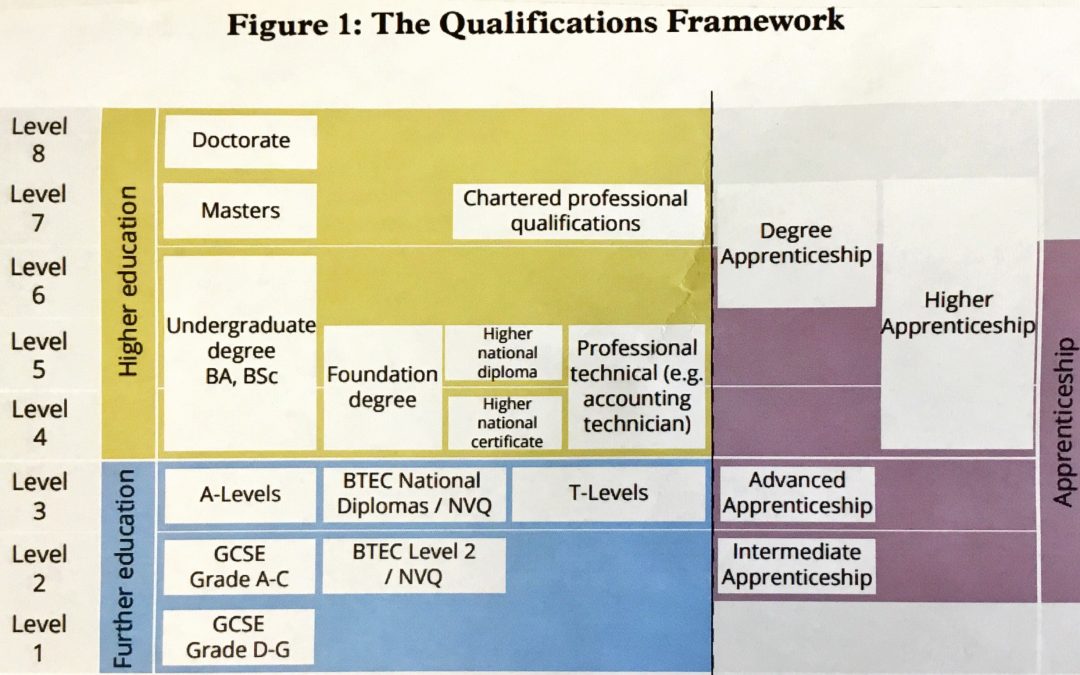Above my desk at GuildHE is a diagram entitled “the UK qualifications framework”. It illustrates how FE and HE fit together, across vocational, academic and technical qualifications. A-Levels are broadly equivalent to Advanced Apprenticeships and T-Levels, and a Foundation Degree is roughly the same a Higher National Diploma, or the second year of a three year undergraduate degree.
Our house, disordered
Unfortunately, the reality is rather messier.
Courses are taught in different settings, from universities to colleges and workplaces. Some are funded by income contingent loans, some by employers, others directly by government. In an era where the “A” & “G” of Information, Advice and Guidance are increasingly absent, we can hardly expect students to understand this complexity and make choices that are right for them.
Policy variation inevitably leads to inequalities. Technical education and apprenticeships are seen as less valuable than a university degree – something for “other people’s children”. Loan based financing has meant increased income for universities, while the FE sector has faced a squeeze during the years of austerity. At the same time, there is real concern about the sticker price of a degree, particularly among mature learners.
What’s more, although we act as though there is a Chinese Wall between academic and vocational education, courses and institutions often blur such boundaries. There are inevitably academic elements in vocational education and vice versa, and FE and HE delivery takes place in both universities and colleges.
Talkin’ bout a revolution?
This is a problem we all know about, but rather than taking the bull by the horns, successive governments have chosen to tinker around the edges. Philip Augar’s review panel, with its remit across all post-18 education, represented a new opportunity.
To their credit, in some ways, the panel has grappled with this. One key recommendation in the Augar report is that maintenance support, both through grants and loans, be standardised across “the full range of qualifications at Levels 4 to 6”. If accepted, this would represent a significant step towards a more integrated approach
Yet in other areas, the panel continued to think in silos. The recommendation that students should be able to access flexible credit-based funding for qualifications at levels 4, 5 and 6, for example, is limited to prescribed HE courses, while funding for FE and apprenticeships remains separate.
More tinkering around the edges.
Where do we go from here?
There is a vision of post-18 education which is truly integrated. Where students can move in and out of different types of education, and build up academic credit to reach higher level qualifications. Where funding is determined by your level of study, irrespective of the context (for example, with government funding for accredited professional qualifications at level 5, and income contingent loans for advanced study to degree level and above). This would allow the Apprenticeship Levy to be repurposed to support more flexible study models (as GuildHE has called for), encouraging businesses to invest in their workforce.
To achieve this will require a radical shift in the way post-18 education is approached.
The Augar panel took steps in the right direction but did not make the big leap, instead maintaining the illusory divide between FE, HE and apprenticeships. Luckily, the panel only informs a DfE review, which will in turn feed into the Comprehensive Spending Review (due in Autumn 2019, but unlikely to happen before 2020).
The Spending Review is a place for big ideas and big changes. What’s more, when it happens, there will be a new Prime Minister, and likely as not, new ministers, keen to put their own stamp on the sector. Let’s encourage policymakers to be bold, and make real a system which truly treats all students equally, and gives them equal opportunities to succeed.

